Do-it-yourself water heating: all about water heating systems
If a country house is actively operated not only in the summer season, but also in the cold season, the creation of a high-quality heating system in it is an urgent need.
Different heat carriers can be used in heat supply lines: air heated to 60 ° С, water vapor at 130 ° С and water with a temperature of 95 ° С. Most often, water heating is used.
One of the main advantages of this coolant is the ability to equip various water heating systems, depending on the design features of the house, personal preferences and other factors.
In the article we described a detailed classification of water heat supply schemes, outlined the features of each option, and also provided recommendations for choosing the main components of the system. The information provided will help to design the heating of a private house.
The content of the article:
- Classification of water heating systems
- Requirements for the operation of the heat supply system
- Equipment power calculations
- Water heating systems
- Installation methods for water heating systems
- Open and closed heating systems
- Elements of the heating system
- Water system "Warm floor"
- Skirting heating system
- Conclusions and useful video on the topic
Classification of water heating systems
Depending on the location of the place of heat production, water heating systems are divided into centralized and local. In a centralized manner, heat is supplied, for example, by apartment buildings, various institutions, enterprises and other facilities.
In this case, heat is generated in thermal power plants (cogeneration plants) or boiler houses, and then delivered to consumers via pipelines.
Local (autonomous) systems provide heat, for example, private homes. It is produced directly at the heat supply facilities themselves. For this purpose, furnaces or special units that operate on electricity, natural gas, liquid or solid combustible materials are used.
Depending on the method by which the movement of water masses is ensured, heating can be with forced (pumping) or natural (gravitational) movement of the coolant. Forced circulation systems can be with ring circuits and with primary-secondary circuit designs.
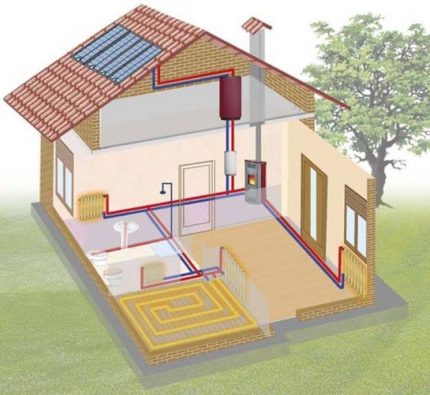
In accordance with the direction of movement of water in the supply and return pipelines, the heat supply can be with the associated and deadlock heat carrier movement. In the first case, water moves in the highways in one direction, and in the second - in different directions.
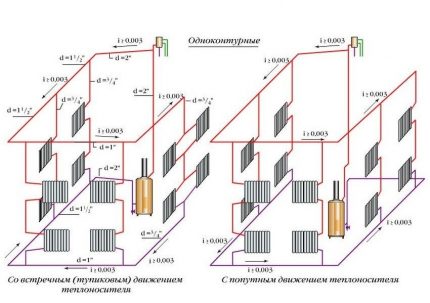
Heating pipes can be connected to heating devices in different schemes. If the heaters are connected in series, this scheme is called single-tube, if in parallel - two-pipe.
There is also a bifilar scheme in which at first all the first halves of the devices are connected in series, and then, to ensure the reverse outflow of water, their second halves.
The location of the pipes connecting the radiators gave the name to the wiring: distinguish between its horizontal and vertical variety. According to the assembly method, collector, tee and mixed pipelines are distinguished.
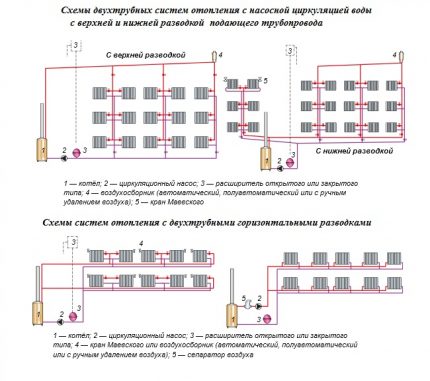
In those residential buildings where there are no basements, but there is an attic, heating systems with an upper wiring are used. In them, the supply line is located above the heating appliances.
For buildings with a technical basement and a flat roof, heating with a lower wiring is used, in which the water supply and drain pipes are below the heating devices.
There is also a wiring with an “overturned” coolant circulation. In this case, the return heat supply line is located below the devices.
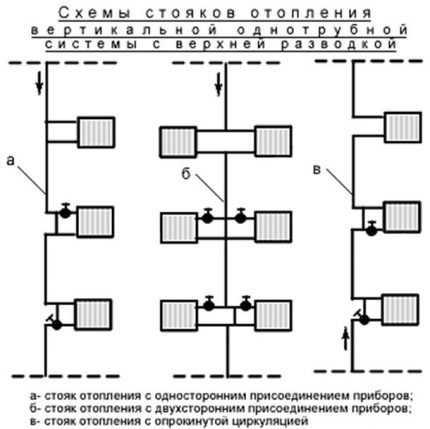
Requirements for the operation of the heat supply system
With all the variety of water heating systems, a number of general requirements are presented to their work.
They have to:
- evenly warm all the air in the rooms;
- be maintainable;
- Do not create difficulties during operation;
- be linked to ventilation systems;
- be regulated.
The principle of operation of the heating system itself is also common: the water is heated, after which it circulates through the pipeline and gives off the received heat, warming the rooms.
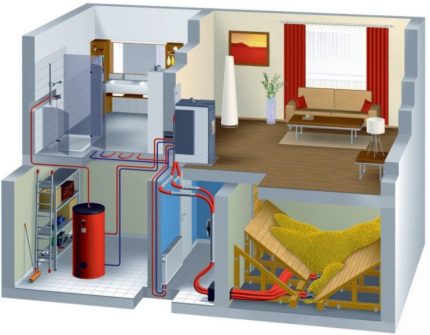
Equipment power calculations
Indoor temperature depends on the following factors:
- air temperature outside the building;
- wall thickness of the house and the quality of its individual elements;
- heat capacity of materialsof which the house is built.
When calculating the heat demand of your home, you need to consider all factors, including heat loss through windows and doors, walls and floors with ceilings. Special norms necessary in the calculation process should be applied taking into account the climatic conditions of the area in which the residential property is located, and the degree of existing thermal insulation.
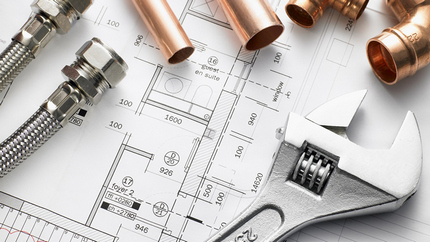
The greatest heat loss occurs through the exterior walls of the house. With increasing temperature differences inside the house and outside the building, heat loss also increases.
If we take into account the material from which the external walls were built, and the thickness of these walls, then for an external air temperature of -30 ° C, the heat loss will be different and will be:
- brick with internal plaster - 89 W / m² (in 2.5 bricks), 104 W / m² (in 2 bricks);
- chopped with inner lining (250 mm) - 70 W / m²;
- from timber with internal lining - 89 W / m² (180 mm), 101 W / m² (100 mm);
- frame with expanded clay inside (200 mm) - 71 W / m²;
- foam concrete with internal plaster (200 mm) - 105 W / m².
However, heat loss occurs not only through the outer walls, but also through other building envelopes.
At the same - 30 ° C they will be for:
- wooden floors of the attic - 35 W / m²;
- basement flooring - 26 W / m²;
- double wooden doors without insulation - 234 W / m²;
- double-glazed windows - 135 W / m².
To calculate the total heat loss of a building, you need to calculate the area of all enclosing structures in square meters, multiply by the heat loss standard for the types of structures taking into account the materials from which they are made, and summarize the results.
The calculation should be done based on the minimum seasonal temperature of a particular area. Heat losses through the walls are calculated separately, as it is necessary to take into account the area of glazing and doorways.
Losses through floors without hatches in the attic or underground are calculated for the entire area as for single structural elements.
The heating boiler is chosen taking into account the fact that its capacity should be sufficient to compensate for heat loss with a 20-30 percent margin.
The procedure for calculating the thermal power of the equipment that will be used for installation of the heating system is given in the video clip in the final part of the article.
On our site there is a block of articles devoted to the calculation of water heating, we recommend that you read:
- Hydraulic calculation of the heating system on a specific example
- Calculation of water heating: formulas, rules, examples of implementation
- Thermal calculation of a heating system: how to correctly calculate the load on a system
Water heating systems
With all the external differences and various wiring diagrams, the basic principle of operation of water heating systems is the same. The heat carrier heated in the boiler is transported through a pipeline to heating devices.
Cooling down, water transfers heat to the environment, after which it returns to the place where it will be heated. This cycle repeats over and over.
Natural and forced circulation
In private houses, the following types of heating systems are used:
- with natural circulation;
- with forced circulation.
Natural circulation. Its performance is based on the difference in density between hot and cold. The upper positions of such a system are occupied by warm water, and the lower ones by cold. Cooling down, warm water moves down, and heating up.
The second factor that provides the natural circulation of water masses is the slope under which the pipes are installed.
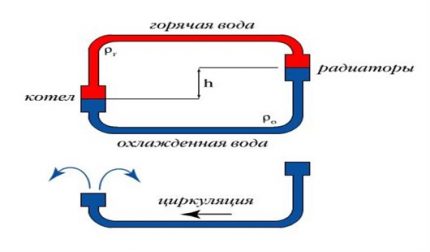
Advantage circuits with natural circulation is its complete independence from energy supply.
She has many more disadvantages:
- small radius of actionI, not exceeding 30 m in horizontal dimension;
- heating time - a long period of reaching operating temperatures at all points of the system at startup after a long break;
- risk of shutdown due to the formation of ice in the open expansion tank.
The diameter of the pipeline should be large enough due to the low circulation pressure in the circuit. This factor also affects the choice of batteries, because modern radiators have too narrow a cross section, which creates additional resistance that counteracts the circulation of "gravity".
In order to further stimulate the movement of the coolant, the pipeline is constructed with a slope so that an average of 3 mm falls on 1 linear meter. Correct installation of pipes at the right angle is not an easy task, but without its solution, the system will function much slower and more efficiently.
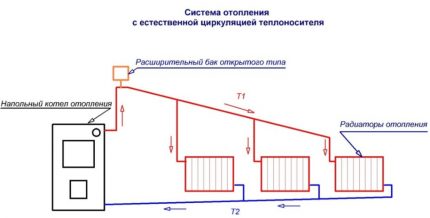
The coolant leaks to distant radiators of gravitational systems already substantially cooled down. To maintain the heating temperature, cast-iron radiators should be used. To balance the temperature difference, distant batteries should have more sections than those closest to the boiler.
Forced circulation provides a pump. The circuit may contain either one or several pumps. The use of several pumps is preferable: an emergency shutdown of one of them will not damage all heating.
The coolant moves cyclically along a closed circuit, into which an expansion tank is included, which eliminates the evaporation of water.
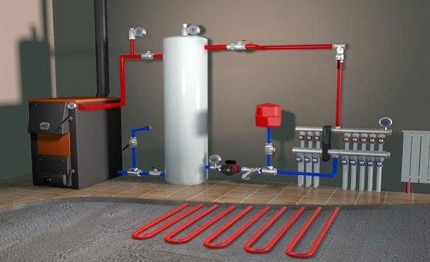
Benefits forced circulation systems:
- for the installation of heating, you will need more pipes, but a smaller diameter;
- You can use different types of radiators and heat pipes with small diameters;
- the temperature of the heaters is easier to regulate;
- the range of action is significantly expanded due to artificial stimulation of the movement of the coolant;
- the possibility of using heating units with enhanced coolant characteristics.
The disadvantage of forced systems is dependent on energy supply. In order to avoid incidents with complete inactivity of heating, it is recommended to stock up on a diesel or gasoline generator.
In addition, the disadvantages include:
- the need for accurate calculation the diameter of the pipeline, as too narrow channels will sharply increase the hydraulic resistance, and when circulating through excessively wide pipes, the coolant will “make noise”;
- considerable construction cost due to the almost double length of the pipeline, the inclusion of one or two circulation pumps, if necessary, booster pump;
- mandatory use of expensive regulators coolant flow, its temperature and pressure in the system.
The correct choice of the type of circulation depends on the individual characteristics and the location of the building in which the water heating will be mounted. However, schemes with natural movement have recently begun to be resorted to less and less, using them mainly in buildings for temporary residence.
Most often, private homes are equipped with systems with artificial coercion of the movement of the coolant due to significantly greater capabilities.
Combined Circulation Systems
The combined system can function in both natural and forced mode. This means that during its installation it is necessary, as in the case of using natural circulation, to provide for a pipe slope of 3-5 mm per linear meter, as well as the installation of a pump, as for forced circulation.
A solid fuel boiler is usually present in such a heating circuit.

The point of using the combined system is that it will continue to operate even in the event of a power outage. But a sudden shutdown of heating in the winter threatens not only with lowering the temperature in the room.
Elements of the heating system can simply fail, since water, expanding during freezing, will violate their tightness.
Installation methods for water heating systems
Consider two main schemes for installing heating systems.
Single pipe heating system
The single-pipe design of the pipeline is characterized by a direct sequence of supplying the coolant to the radiators. The coolant fills and warms up first the first battery, then the next and so on.
Two pipes are supplied from each pipe to each radiator: the first is needed to supply coolant, and the second is to drain partially cooled water.
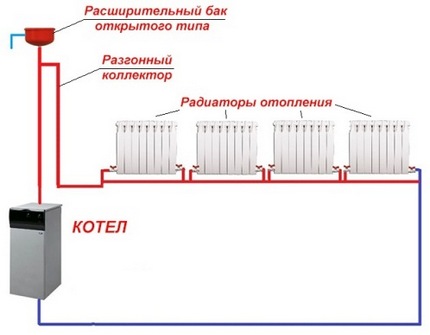
A feature of such a scheme is the relatively low heating of the last battery compared to the first, since water "gets" to it, having already lost some of its heat.
Another minus single pipe heating option it is considered that it is impossible to stop the flow of coolant to one specific radiator, in case of breakdown. Will have to shut down the entire system.
Two-pipe system and its variants
In a two-pipe heating circuit, as the name implies, not one, but two pipes are involved. At the same time, each of the batteries is connected in one pipe to the main through which the coolant is supplied, and the second to the return pipe. It turns out that separate pipes are provided for the hot and cooled coolant.
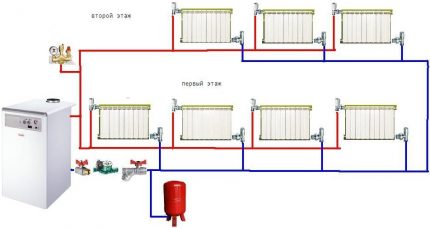
Thanks to this heating design, the water in all radiators has almost the same temperature. The operation of such a system is easier to control, adjust and automate.
The two-pipe system, in turn, is divided into two types:
- with the top gasket of the feed pipe, i.e. with top wiring;
- with the bottom laying of the supply pipe, i.e. with bottom wiring.
Top wiring systems are built primarily in multi-storey buildings with an attic. Schemes with lower wiring are a priority in private low-rise construction, because they allow you to hide the laying of the pipeline to the maximum and eliminate or reduce the number of risers.
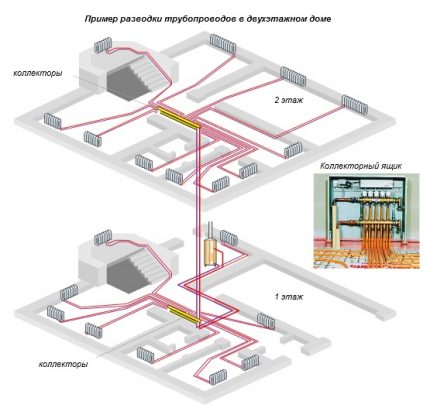
Comparative characteristics of single pipe and double pipe heating system given in the video material, which is located at the bottom of our article.
Open and closed heating systems
In addition to the types of water heating systems that we have already considered, there is a division into an open and closed design.
Open heating system consists of a boiler (any one is used except electric), pipelines, radiators and an expansion tank, which receives excess water when it expands during heating.
The tank is not tight, water from the system can evaporate, so its level must be controlled and refilled if necessary.
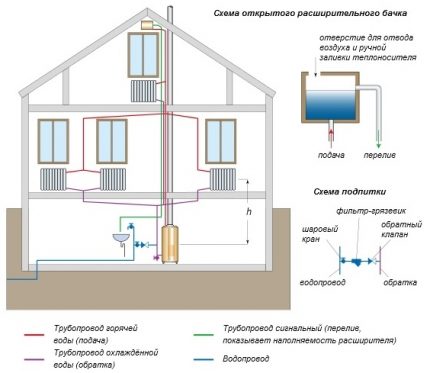
Pump in open heating system not applicable. The heating boiler is located at its lowest point, and the expansion tank is at its highest point.
Closed construction is sealed. It includes all the same elements as in the open. But since the movement of the coolant in it is forced, the mandatory list of elements is supplemented by a circulation pump.
The expansion tank, which is part of a closed structure, consists of two sealed parts separated by a diaphragm. If there is an excess of expanded fluid in the system, it enters one of the chambers of the tank, forcing the diaphragm into a second chamber filled with nitrogen or air.
With the expansion of the coolant, the pressure in the system rises, the part of the tank filled with water, seeks to displace and compress the gas mixture. If the limit value of the pressure in the tank is exceeded, a safety valve is activated, which dumps excess coolant.
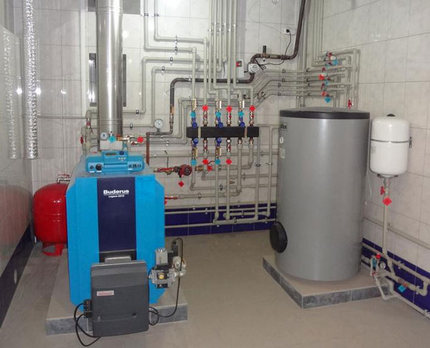
Each of the heating systems has its own advantages and disadvantages.They differ in a number of characteristics and are suitable for various objects. If you need to heat a small private house or cottage, use a simple and reliable open design.
More difficult to install and operate closed heating system more often used in solid cottages and in multi-storey buildings.
Elements of the heating system
Since we are going to mount water heating in the house with our own hands, we need to have an idea about the components of the proposed design.
Determining a suitable boiler
The boiler is the heart of the heating system. It is very important to choose it correctly, since the reliability of heat supply depends on it in many respects.
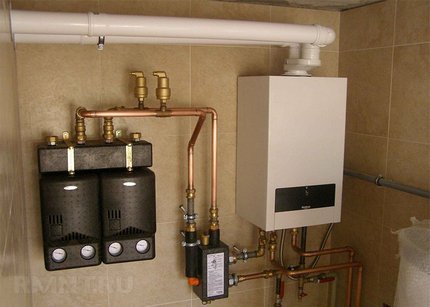
Depending on the fuel used in the boiler, the following types of these devices are distinguished:
- Gas. This boiler is most popular among consumers. It is easy to install, it works without any noise. Gas is relatively inexpensive and generates a lot of heat during combustion. But for its use, you need to get permission, order the installation of the supply line and organize exhaust ventilation in the boiler room.
- Electric. These boilers are the safest. The place of their installation does not need to be additionally equipped. During their operation, an open flame and combustion products are not formed, which could be poisoned. But the efficiency of this device is relatively small, electricity is expensive, and an energy-intensive boiler requires a reliable power supply.
- Liquid fuel. Unlike gas, these boilers are equipped with a special kind of burners. For this equipment you need a special boiler room. Liquid fuel quickly pollutes the boiler.
- Solid fuel. In these devices, coal briquettes and other types of solid fuel are burned. If you are ready to prepare firewood or coal for the entire cold season, then you can use this option.
Combined boilers are considered the most reliable, in which different types of fuel can be used. There is only one drawback of such equipment - such boilers are expensive.
What are heating radiators
In order not to be disappointed as a result of the work done, you need to responsibly approach the choice of radiators. In this case, you should focus not so much on aesthetic qualities as on the technical characteristics of the batteries. And technical properties largely depend on the material of manufacture of these products.

Radiators are:
- Steel. These inexpensive products are too susceptible to corrosion. If in the summer, when heating is not used, water from the system is drained, the service life of steel radiators can be significantly reduced.
- Aluminum. These attractive-looking radiators warm up quickly enough. Only significant pressure drops affect them negatively. In private homes, this danger does not threaten them.
- Bimetallic. Such batteries from aluminum got corrosion resistance, and from steel - high heat transfer.
- Cast iron. These products are expensive, but will last a very long time. They heat up for a long time, but then cool for a long period of time. A significant weight of cast iron products is not an obstacle in their operation, but can slow down the installation process.
There are new models of radiators, on the inner surface of which a protective coating is applied. Such batteries cost a little more, but the money spent on them pays off with interest.
How not to make a mistake with pipes
To install the heating system, many pipes are required.
Which of them to give preference:
- Metal. The service life of such pipes is not too long. Over time, metal products may rust. They are mounted using threaded connections.
- Polymer. This is an inexpensive, but fairly reliable material, characterized by resistance to corrosion. These pipes can be mounted even by a layman. The pipeline from polymer pipes will last a very long time.
- Metal-plastic. The composition of these pipes is aluminum and plastic. The pipeline of them is collected on threaded or press joints. As a by-product of the high coefficient of thermal expansion of these pipes, they may crack if there is a sharp change in water temperature.
If the owners of the house have no limitations in means, it makes sense to arrange a heating distribution from copper pipes. This is very expensive material, but the cost of it justifies itself. Such pipes are reliable and durable.
They tolerate high temperature and pressure well. For their installation, use soldering - silver-containing high-temperature solder.
All that we told you above was about radiator water. But water as a coolant can be used in other heating systems.
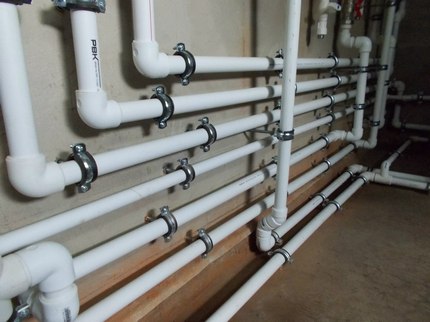
Read more about the characteristics and choice of pipes for heating, see this article.
Water system "Warm floor"
“Warm floor” can both successfully complement radiator water heating, and become the only source of space heating, if we are talking about a low-rise building. The huge advantage of the Warm House is that this system provides conditions that fully meet the sanitary and hygienic standards of the room.
The air heats up unevenly along the height of the room: in the upper part of the rooms it is colder, and in the lower part it is warmer.
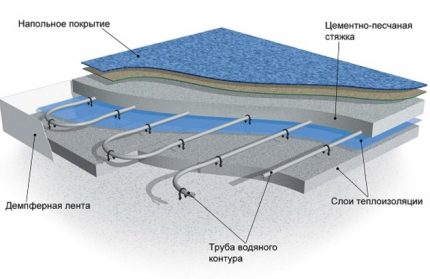
The temperature of the system is only 55 ° C, which meets the design standards. Exercise floor heating installation spend the entire area of each of the premises. This is a rather complicated work, which can be qualitatively performed only at the stage of building a house. The operation of the system also causes a number of difficulties.
Skirting heating system
If the installation of the “Warm House” is difficult, and the radiators spoil the interior of the room, you can use the baseboard heating system.
In this type of heating, the installation of pipes is carried out behind the baseboard, that is, slightly above the floor level. At the same time, the room, as in the case of “Warm floor”, is warming up in the correct sequence.
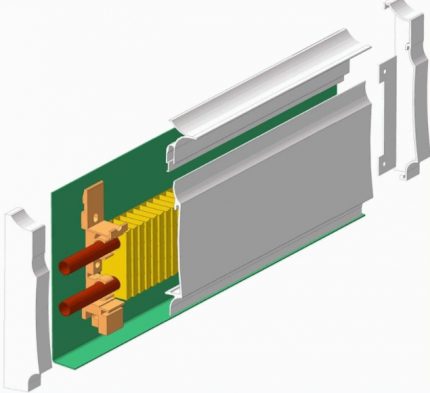
At the same time, the floor is heated, which creates favorable conditions at any time of the year. Skirting heating is becoming more and more popular and is gradually becoming fashionable.
Conclusions and useful video on the topic
Comparison of two-pipe and single-pipe heating systems:
The house you are going to live all year round needs heating in the cold season. To make your living conditions comfortable, you need to choose a water heating system that is most suitable for your individual conditions.
We hope that the information in this article will help you make the right choice. After all, high-quality heating is not only comfort and coziness. It is also a prerequisite for maintaining your health.
Have something to supplement, or have questions about water heating systems? You can leave comments on the publication and participate in discussions. The contact form is located in the lower block.

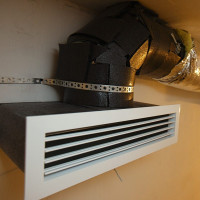 DIY air heating: all about air heating systems
DIY air heating: all about air heating systems 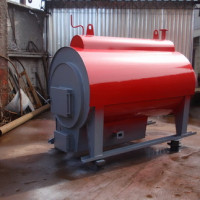 How to make steam heating yourself: device, rules and requirements
How to make steam heating yourself: device, rules and requirements 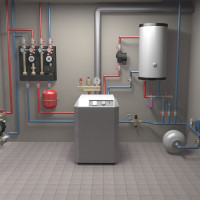 Water heating in a private house: rules, norms and organization options
Water heating in a private house: rules, norms and organization options 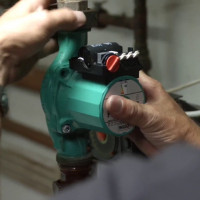 How are heating systems with pump circulation arranged: organization schemes
How are heating systems with pump circulation arranged: organization schemes  Schemes of a steam heating device + example of calculation of a steam system
Schemes of a steam heating device + example of calculation of a steam system 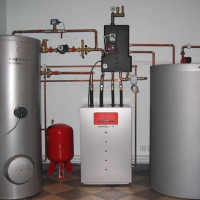 Closed heating system: schemes and installation features of a closed type system
Closed heating system: schemes and installation features of a closed type system  How much does it cost to connect gas to a private house: the price of organizing gas supply
How much does it cost to connect gas to a private house: the price of organizing gas supply  The best washing machines with dryer: model rating and customer tips
The best washing machines with dryer: model rating and customer tips  What is the color temperature of light and the nuances of choosing the temperature of the lamps to suit your needs
What is the color temperature of light and the nuances of choosing the temperature of the lamps to suit your needs  Replacement of a geyser in an apartment: replacement paperwork + basic norms and requirements
Replacement of a geyser in an apartment: replacement paperwork + basic norms and requirements
The “underfloor heating” system and plinth heating system are really wonderful, convenient, practical and aesthetic ways to heat your home. This is undeniable. But all this is wonderful only under one condition - competent design and high-quality installation. As well as high-quality materials of such systems. And that is, such clever people who make a “warm water floor” not in country houses, but in ordinary apartments of high-rise buildings. Naturally, while looking for cheaper offers and trying to save on what you can. And then the neighbors from below begin to drip from the ceiling, and the ceiling on the weight of such a system is not designed. Here are joys for people - expertise and courts.
Installation of heating is actually simple for those who know how to solder plastic pipes. I did it extremely efficiently - a low-power boiler (Chinese Solly18h) was installed by plumbers, and I installed the wiring with radiators myself, and as operation showed, it was very successful. I took the training video as a basis - almost identical to this information. Did everything - three days (3-room apartment). I saved a lot of money and gained useful experience.